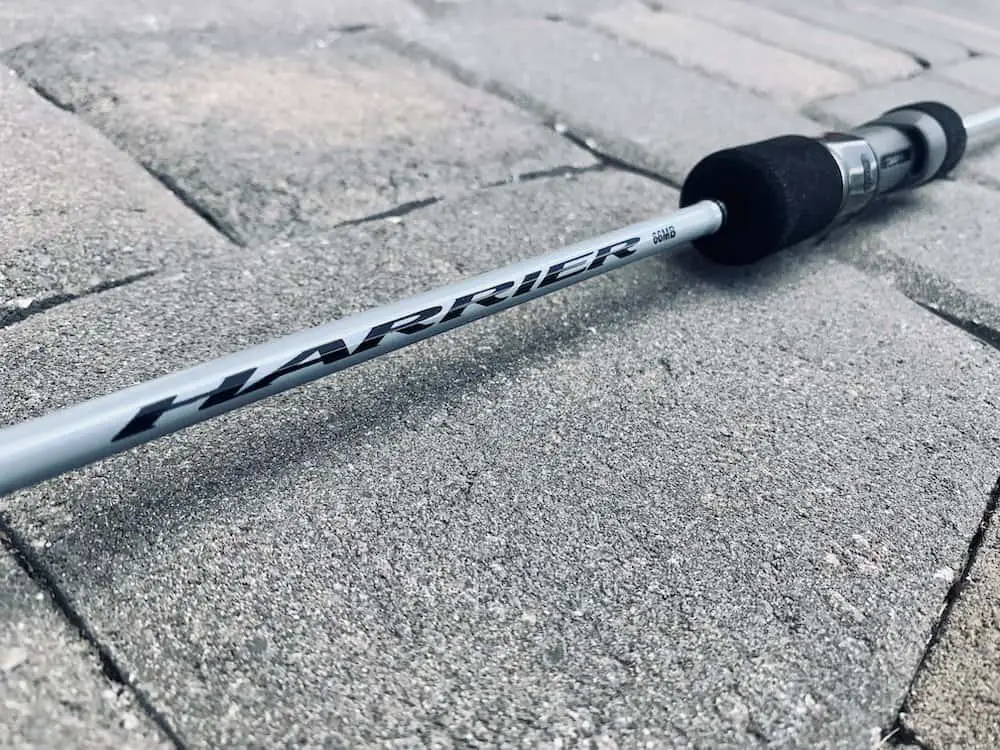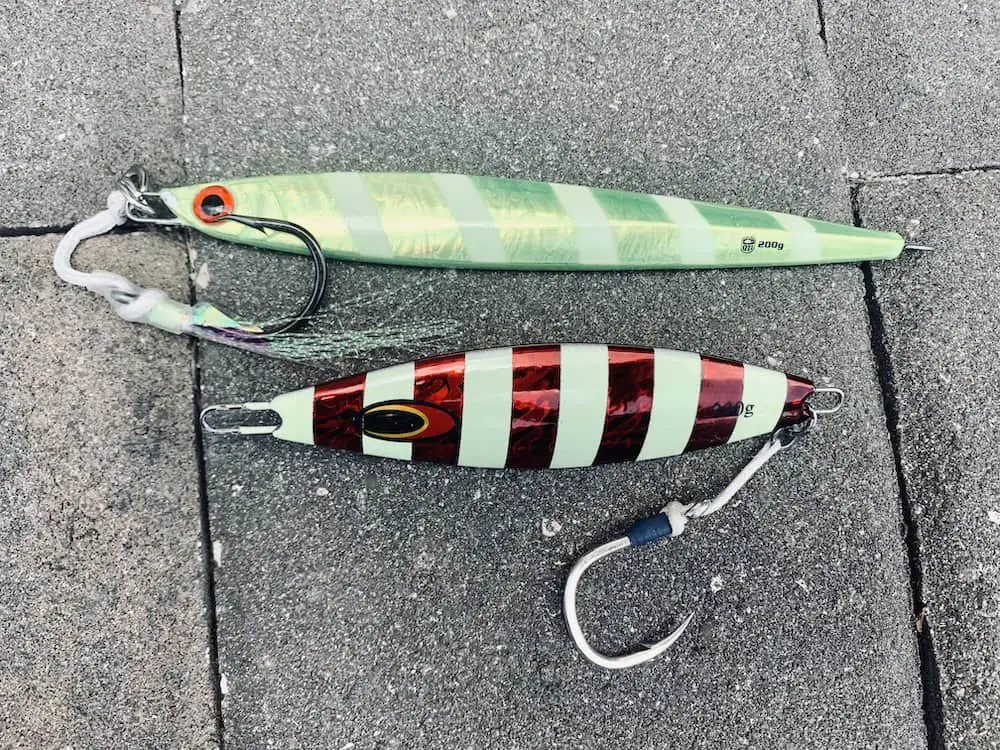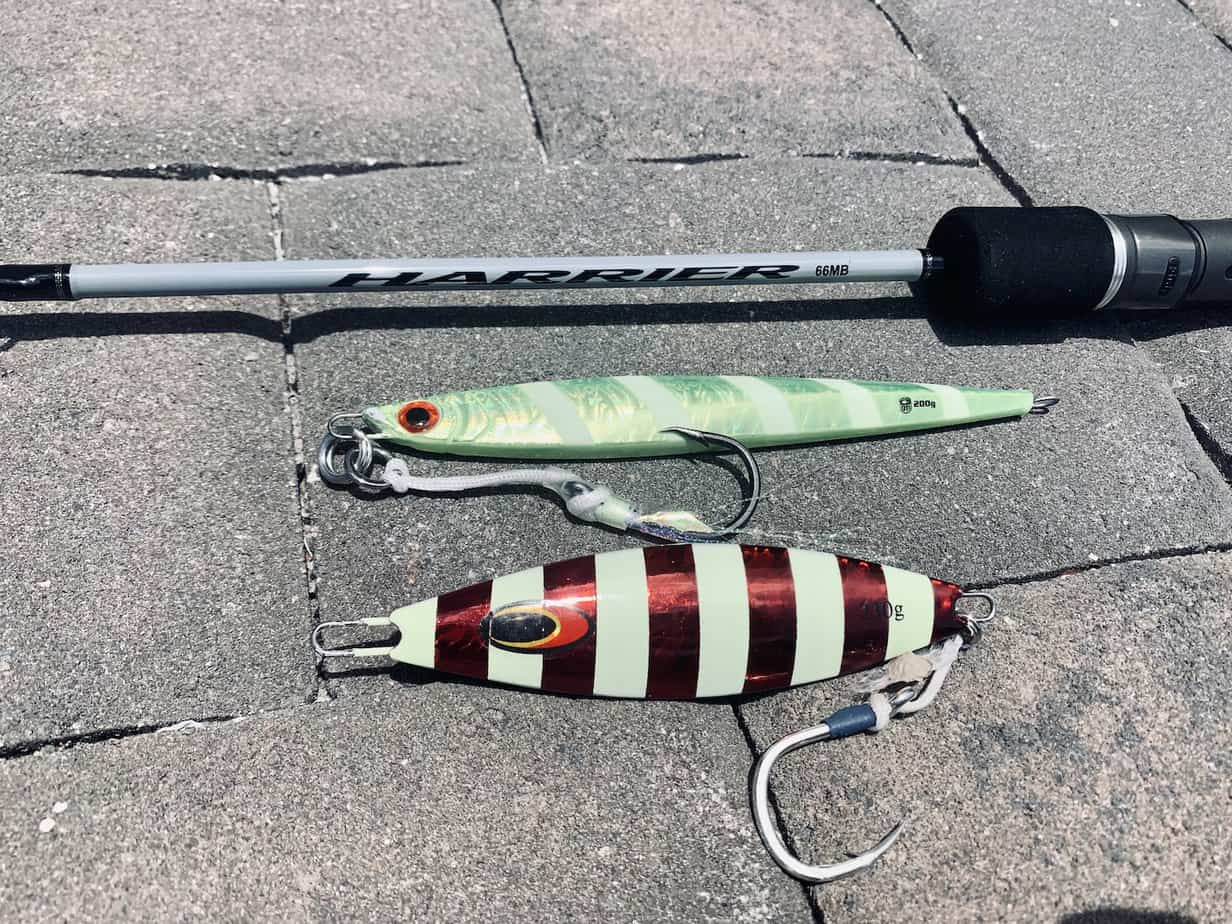Slow jigging and fast jigging are two very different methods of working two different types of jigs to attract fish. Slow jigging and fast jigging differ by mimicking different baitfish behavior: a slow jigging technique imitates a dying baitfish while a fast jigging technique imitates a fleeing baitfish. A slow jig wobbles and lays horizontally as it falls to mimic a dying baitfish. A fast jig darts erratically during the retrieve to mimic a panicking and fleeing baitfish. The rod motions match each style: slow and rhythmic for slow pitch jigging and fast and rhythmic for speed jigging. In slow pitch jigging, the bite is softer and the lure is struck on the fall. In speed jigging, the bite is hard and the lure is struck during the retrieve. In slow jigging, the angler retrieves as the rod is being pulled up, and in speed jigging, the angler reels in the slack line as the rod tip is lowered. Speed jigging requires heavier tackle than slow pitch jigging to accommodate the harder strikes. Slow jigging tends to be more focused near the bottom of the water column, whereas speed jigging spends an equal amount of time throughout the entire water column.
Speed jigging, also called fast jigging, is done by first letting the lure fall the bottom in freespool, then doing a constant jig up, and retrieve while letting the rod tip point back down to the water. The slack line is retrieved quickly to ensure the jig is constantly darting. This rhythmic motion can be a challenge at first, but once you get the hang of it, it becomes much easier. The jig is normally shaped like a stick and heavy so it sinks quickly. There are tapered edges to make the jig dart in aggressive ways on the way up. This action mimics that of an injured baitfish fleeing from its predator. Speed jigging can be used to target big pelagics and the strikes are usually very hard. To set the hook, just keep jigging for a little bit longer after the strike. This method of jigging can be exhausting because of the work required to work the jig quickly and then fighting the large fish after the strike.
Slow pitch jigging is a much newer style of jigging, in comparison to fast jigging which has been around for centuries. Slow pitch jigging also starts with letting the jig fall to the bottom in freespool and then the rod is jigged up and the lure falls again. It's a much slower rhythmic motion and the strikes are usually much softer. For anglers to feel the bite and feel the soft jig motions, the rod must be very sensitive and a slow action for a nice parabolic bend. The jigs are usually wide and somewhat flat to let the lure lie horizontally and wobble during the fall. When slow pitch jigging, the bites usually happen during the fall and are softer. The jigs often have two assist hooks to increase hookup rates.
Deciding Which Jigging Setup to Buy First: Slow or Fast? Which Is Better?
Slow and fast jigging techniques are both effective, however slow pitch jigging is often better because it doesn’t tire out the angler as quickly and entices a convenience bite, rather than relying on a feeding bite. Fast jigging requires the use of heavy stick jigs and a heavier rod and reel to match. Then the angler is constantly jigging the rod up and down while retrieving as fast as he or she can. This is a lot of physical demand on the angler. Slow pitch jigging uses freespool a lot more. In slow pitch jigging, the lure falls to the bottom and stays toward the bottom the majority of the time. You’ll often succeed at catching bottom feeders such as grouper and snapper when slow pitch jigging. The lure works best when its lying horizontal as it falls and the more time the lure spends in that position, the better the odds are for catching fish. In speed jigging, the jig quickly falls and is quickly retrieved and then the process is repeated. In speed jigging, the jig spends about half its time in the position where it will get strikes and in slow pitch jigging, the lure spends much more time in the optimum position.
Considering the technique of speed jigging, it may not be enjoyable to do in very deep water. The deeper the water is, the longer stretch of time the angler needs to consistently be jigging and retrieving as fast as he or she can. This is why speed jigging in deep water for a species such as tuna is especially exhausting. Tuna will strike aggressively and then fight like mad to get away. In deep water, if a fish strikes near the deepest depth, you could have hundreds of yards of line to reel in. In speed jigging, you’ll be using a reel with a lower gear ratio and slower retrieve rate to give you the best power when hooking a big fish. The rod is also yanked up constantly, which gives the lure speed as its moving up the water column. In slow pitch jigging, you’re mostly letting the lure fall and when it comes time to retrieve, you’ll be working with a reel that has a fast retrieve rate.
These two styles of jigging will require different and specialized tackle. Slow pitch jigging is a little easier to do, so I’d recommend starting with a slow pitch jigging setup and learning that technique first. Slow pitch jigging will also help build your confidence since its relatively easy to catch fish as long as you’re properly located near structure or near schooling baitfish. To learn about how I chose my slow pitch jigging rod, reel, and jig, read my article here.
What Power, Action, and Length Should I Look For in a Jigging Rod?
The rods that work best for slow jigging and fast jigging techniques differ. Slow pitch jigging requires a slower action rod, which gives the rod a parabolic bend to best control the action of the jig and the rod taper gives it the sensitivity to feel the soft bites and enough backbone to set the hook. Speed jigging rods are faster action, meaning you’ll reach the backbone of the rod much sooner. This is critical when fighting large pelagic fish in deep offshore waters. Both speed jigging and slow pitch jigging rods are about 6 to 7 feet in length. This length works well for storing on a boat, with the 7 ft fast action rods working well for vertical speed jigging as well as casting.
The power of the rod determines the jig range. If you’re looking to fish in deep waters, say 400 feet, you’ll be using a jig weighing 400 or 450 grams, which will generally mean heavy or extra heavy power.
Speed Jigging Rod: Shimano Trevala PX jigging rod
The Shimano Trevala PX jigging rod is a versatile and lightweight jigging rod. The action is perfect for a speed jigging technique and you can purchase a length long enough to also use the rod for casting. There are plenty of lure rating options on this rod, so it’ll be no problem finding a suitable power, action, lure and line rating for your fishery.
Slow Pitch Jigging Rod: Daiwa Harrier Slow Pitch Jigging Rod

I picked up this Daiwa Harrier Slow Pitch Jigging Rod when I was buying my slow pitch setup. I was very pleased when it came in the mail and I could feel how lightweight yet powerful it was. The price point of $200 was just right to show me that it's a quality rod, without being so expensive that I’d feel bad only using it when I get a chance to go offshore.
Jigging Reels: What Makes For a Good Slow Jigging Reel and a Good Speed Jigging Reel?
The optimum slow pitch jigging and fast jigging reels differ in retrieve rates and gear ratios. A slow pitch jigging reel requires a fast retrieve rate to enable the angler to quickly reel in the slack line and maintain contact with the jig. Slow pitch jigging relies on the angler feeling when the jig is on bottom and when the jig gets a soft strike. These two things cannot be felt when there’s slack in the line, making a bow in the water. Fast jigging reels are the opposite. Vertical speed jigging reels require low gear ratios and low retrieve rates because the jigging of the rod is what’s working the lure and the hard striking pelagic fish require more power to fight.
The gear ratio of a slow pitch jigging reel is usually around 6:1. The gear ratio of a speed jigging reel is usually closer to about 4:1. The retrieve rate of a slow pitch jigging reel is 36 inches per turn (IPT) or higher. The retrieve rate of a speed jigging reel is usually around 28 IPT.
Slow pitch jigging reel: Shimano Ocea Jigger HG models
Speed jigging reel: Shimano Ocea Jigger PG models
The Shimano Ocea Jigger is one of the best known jigging reels in the industry. Its auto-engage clutch helps to never miss a hookset. The gear ratio options make this reel suitable for either type of jigging. The star drag keeps the reel lightweight and the Shielded Anti-Rust Bearings (S ARB) will keep this reel operating smoothly for many, many years.
When Reaching for a Lure In My Jig Bag, How Do I Know If It's a Fast Jig or Slow Jig?
The difference between a fast a slow jig is quite dramatic. A fast jig is meant to sink rapidly and have a darting action when it comes up the water column. A slow jig is meant to sink slowly and flutter on its way down. A fast jig is normally long and slender with tapered edges to cause the darting action. A slow jig is normally shaped like a leaf to provide plenty of surface area to slow down the fall. Both styles of jigs come in similar color patters, with a metallic flash prominent on both styles.

Slow jig: Nomad Buffalo Jig
This wide, leaf-shaped jig has glow in the dark stripes in the Crimson Tide color. Glow in the dark stripes add extra flash to help in deep, dark waters. It’s difficult for the sunlight to penetrate all the way down hundreds of feet of water, so glow in the dark capabilies allow the jig to be seen, when other lures, like metal spoons, would be missed.
Fast jig: Ocean Tackle International (OTI) Ricochet jig
The OTI ricochet jig comes rigged with strong OTI raptor assist hooks that have flash strips also added to them. This further helps catch the eye of the fish and the skirt on the hook disguises the hook for spooked fish.
Slow jigs and fast jigs come similarly rigged with a split ring and assist hook. I’d recommend adding a second hook to your slow jigs to make sure your fish doesn’t get away. Fish will have a softer bite on a slow jig, so a hook in the mouth with a second hook in the face, will ensure the fish doesn’t get away. Shimano also has a nice line of jigging lures, called butterfly jigs, some of which are fast jigs and some are slow jigs. Read more about them here.
If the Fish Aren’t Biting, Can You Speed Jig With a Slow Pitch Rod?
If you compare the lure ratings for slow pitch and fast jigging rods with similar line ratings, the fast jigging rods are rated for much larger jigs. The danger with using a slow pitch rod for speed jigging, is that your rod may not be properly powered for the hard strike and fight of the fish you’ll catch. It is possible to speed jig with a slow pitch rod, but I would highly recommend you lower the weight of your lure to about half the lure rating of the rod. This should give you enough margin to withstand the strike and fight, but it may have the negative effect of not letting you reach the bottom in deep waters. Using a slow pitch rod for speed jigging can likely only be done in about 150 feet of water or less. Remember, slow pitch and speed jigging are specialized techniques, requiring specialized equipment to be properly done.
| Rod | Power | Action | Line Rating | Lure Rating |
| Shimano Trevala PX Casting (TVXFC66H) | Heavy | Fast | 65 lb | 250g |
| Daiwa Harrier SPJ Casting (HSP66XHB) | X-Heavy | Slow | 65 lb | 500g |
While you’re here, don’t miss out on reading my article telling you everything you need to know about jigging leaders and how to choose one. Tight lines, y’all!
Recent Posts
Fat Cow Jig Strips: The Ultimate Bucktail Jig Upgrade for Surf Fishing
As discussed in my previous article, "Surf Fishing with Bucktail Jigs: Ultimate Guide for Beach Anglers," bucktail jigs are a staple in any surf angler's tackle box, offering a versatile way to catch...
In my previous article, "Surf Fishing with Bucktail Jigs: Ultimate Guide for Beach Anglers," I introduced you to the bucktail jig and discussed how versatile of a lure it is for catching a wide range...

